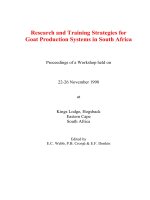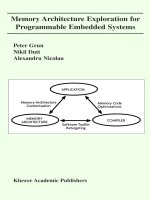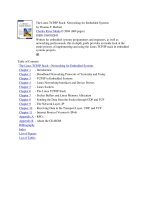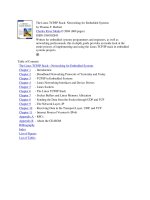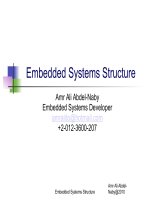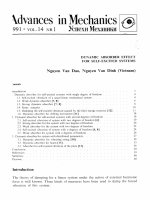memory architecture exploration for programmable embedded systems
Bạn đang xem bản rút gọn của tài liệu. Xem và tải ngay bản đầy đủ của tài liệu tại đây (5.14 MB, 147 trang )
Memory Architecture Exploration
for Programmable Embedded Systems
This page intentionally left blank
MEMORY ARCHITECTURE
EXPLORATION FOR PROGRAMMABLE
EMBEDDED SYSTEMS
PETER GRUN
Center for Embedded Computer Systems,
University of California, Irvine
NIKIL DUTT
Center for Embedded Computer Systems,
University of California, Irvine
ALEX NICOLAU
Center for Embedded Computer Systems,
University of California, Irvine
KLUWER ACADEMIC PUBLISHERS
NEW YORK, BOSTON, DORDRECHT, LONDON, MOSCOW
eBook ISBN: 0-306-48095-6
Print ISBN: 1-4020-7324-0
©2002 Kluwer Academic Publishers
New York, Boston, Dordrecht, London, Moscow
Print ©2003 Kluwer Academic Publishers
All rights reserved
No part of this eBook may be reproduced or transmitted in any form or by any means, electronic,
mechanical, recording, or otherwise, without written consent from the Publisher
Created in the United States of America
Visit Kluwer Online at:
and Kluwer's eBookstore at:
Dordrecht
Contents
List of Figures
List of Tables
Preface
Acknowledgments
ix
xiii
xv
INTRODUCTION
1.
1.1
1.2
1.3
Motivation
Memory Architecture Exploration for Embedded Systems
Book Organization
1
1
2
7
9
9
2.
RELATED WORK
2.1
2.2
2.3
2.4
2.5
High-Level Synthesis
Cache Optimizations
Computer Architecture
Disk File Systems
Heterogeneous Memory Architectures
2.5.1 Network Processors
2.5.2 Other Memory Architecture Examples
10
11
12
13
14
15
16
17
17
18
20
22
23
23
2.6
Summary
3.
EARLY MEMORY SIZE ESTIMATION
3.1
3.2
3.3
Motivation
Memory Estimation Problem
Memory Size Estimation Algorithm
3.3.1
3.3.2
3.3.3
Data-dependence analysis
Computing the memory size between loop nests
Determining the bounding rectangles
vi
MEMORY ARCHITECTURE EXPLORATION
3.3.4
3.3.5
Determining the memory size range
Improving the estimation accuracy
24
25
25
27
28
29
3.4
3.5
3.6
3.7
Discussion on Parallelism vs. Memory Size
Experiments
Related Work
Summary
4.
EARLY MEMORY AND CONNECTIVITY
ARCHITECTURE EXPLORATION
31
31
32
32
34
37
37
39
39
40
41
45
46
47
48
51
55
57
59
59
60
72
74
75
79
79
80
81
83
4.1
4.2
Motivation
Access Pattern Based Memory Architecture Exploration
4.2.1
4.2.2
4.2.3
Our approach
Illustrative example
The Access Pattern based Memory Exploration (APEX)
Approach
Access Pattern Clustering
Exploring Custom Memory Configurations
Experiments
Experimental Setup
Results
Related Work
4.2.3.1
4.2.3.2
4.2.4
4.2.4.1
4.2.4.2
4.2.5
4.3
Connectivity Architecture Exploration
4.3.1
4.3.2
4.3.3
Our approach
Illustrative example
Connectivity Exploration Algorithm
Cost, performance, and power models
Coupled Memory/Connectivity Exploration strategy
Experiments
Experimental Setup
Results
Related Work
4.3.3.1
4.3.3.2
4.3.4
4.3.4.1
4.3.4.2
4.3.5
4.4
4.5
Discussion on Memory Architecture
Summary and Status
5.
MEMORY-AWARE COMPILATION
5.1
5.2
Motivation
Memory Timing Extraction for Efficient Access Modes
5.2.1
5.2.2
Motivating Example
Our Approach
Contents
vii
5.2.3
5.2.4
TIMGEN: Timing extraction algorithm
Experiments
Experimental Setup
Results
Related Work
5.2.4.1
5.2.4.2
5.2.5
5.3
Memory Miss Traffic Management
5.3.1
5.3.2
5.3.3
Illustrative example
Miss Traffic Optimization Algorithm
Experiments
Experimental setup
Results
Related Work
5.3.3.1
5.3.3.2
5.3.4
5.4
Summary
84
89
89
90
92
94
95
98
6.
EXPERIMENTS
6.1
6.2
Experimental setup
Results
6.2.1
6.2.2
6.2.3
The Compress Data Compression Application
The Li Lisp Interpreter Application
The Vocoder Voice Coding Application
101
102
102
105
107
109
109
110
110
114
116
117
119
119
120
121
127
Summary of Experiments
6.3
7.
CONCLUSIONS
7.1
7.2
Summary of Contributions
Future Directions
References
Index
This page intentionally left blank
List of Figures
1.1
1.2
2.1
3.1
3.2
3.3
3.4
3.5
3.6
3.7
3.8
3.9
3.10
4.1
4.2
4.3
4.4
4.5
4.6
4.7
The interaction between the Memory Architecture, the
Application and the Memory-Aware Compiler
Our Hardware/Software Memory Exploration Flow
Packet Classification in Network Processing
Our Hardware/Software Memory Exploration Flow
The flow of MemoRex approach
Outline of the MemoRex algorithm.
Illustrative Example
Memory estimation for the illustrative example
(a) Accuracy refinement, (b) Complete memory trace
Input Specification with parallel instructions
Memory behavior for example with sequential loop
Memory behavior for example with forall loop
Memory Size Variation during partitioning/parallelization
29
The flow of our Access Pattern based Memory Explo-
ration Approach (APEX).
Memory architecture template.
Example access patterns.
Self-indirect custom memory module.
Access Pattern Clustering algorithm.
Exploration algorithm.
Miss ratio versus cost trade-off in Memory Design Space
Exploration for Compress (SPEC95)
3
5
14
18
21
21
22
24
24
26
26
26
33
34
35
36
38
40
42
x
MEMORY ARCHITECTURE EXPLORATION
4.8
4.9
Exploration heuristic compared to simulation of all ac-
cess pattern cluster mapping combinations for Com-
press
The flow of our Exploration Approach.
(a) The Connectivity Architecture Template and (b) An
Example Connectivity Architecture.
The most promising memory modules architectures for
the compress benchmark.
The connectivity architecture exploration for the com-
press benchmark.
Connectivity Exploration algorithm.
Cost/perf vs perf/power paretos in the cost/perf space
for Compress.
Cost/perf vs perf/power paretos in the perf/power space
for Compress.
Cost/perf paretos for the connectivity exploration of
compress, assuming cost/perf and cost/power memory
modules exploration.
Perf/power paretos for the connectivity exploration of
compress, assuming cost/perf and cost/power memory
modules exploration.
Cost/perf vs perf/power paretos in the cost/perf space
for Compress, assuming cost-power memory modules
exploration.
Cost/perf vs perf/power paretos in the perf/power space
for Compress, assuming cost-power memory modules
exploration.
Cost/perf vs perf/power paretos in the cost/perf space
for Vocoder.
Cost/perf vs perf/power paretos in the perf/power space
for Vocoder.
Cost/perf vs perf/power paretos in the cost/perf space
for Li.
Cost/perf vs perf/power paretos in the perf/power space
for Li.
Analysis of the cost/perf pareto architectures for the
compress benchmark.
Analysis of the cost/perf pareto architectures for the
vocoder benchmark.
4.10
4.11
4.12
4.13
4.14
4.15
4.16
4.17
4.18
4.19
4.20
4.21
4.22
4.23
4.24
4.25
43
48
49
50
52
54
61
62
63
64
65
66
66
67
67
68
68
69
List of Figures
xi
4.26
4.27
Analysis of the cost/perf pareto architectures for the Li
benchmark.
Example memory model architectures.
Motivating example
The Flow in our approach
Example architecture, based on TI TMS320C6201
The TIMGEN timing generation algorithm.
Motivating example
The MIST Miss Traffic optimization algorithm.
The cache dependence analysis algorithm.
The loop shifting algorithm.
Memory Architecture Exploration for the Compress Ker-
nel .
Memory Modules and Connectivity Exploration for the
Compress Kernel.
Memory Exploration for the Compress Kernel.
Memory Exploration for the Li Kernel .
Memory Exploration for the Li Kernel .
Memory Exploration for the Vocoder Kernel.
Memory Exploration for the Vocoder Kernel.
5.1
5.2
5.3
5.4
5.5
5.6
5.7
5.8
6.1
6.2
6.3
6.4
6.5
6.6
6.7
100
100
111
112
113
115
115
116
117
70
76
82
84
86
88
97
98
This page intentionally left blank
List of Tables
3.1
4.1
4.2
4.3
5.1
5.2
5.3
5.4
Experimental Results.
Exploration results for our Access Pattern based Mem-
ory Customization algorithm.
Selected cost/performance designs for the connectivity
exploration.
Pareto coverage results for our Memory Architecture
Exploration Approach.
Dynamic cycle counts for the TIC6201 processor with
an SDRAM block exhibiting 2 banks, page and burst accesses
Number of assembly lines for the first phase memory
access optimizations
Dynamic cycle counts for the TI C6211 processor with
a 16k direct mapped cache
Code size increase for the multimedia applications
28
45
71
72
91
91
103
104
This page intentionally left blank
Preface
Continuing advances in chip technology, such as the ability to place more
transistors on the same die (together with increased operating speeds) have
opened new opportunities in embedded applications, breaking new ground in
the domains of communication, multimedia, networking and entertainment.
New consumer products, together with increased time-to-market pressures have
created the need for rapid exploration tools to evaluate candidate architectures
for System-On-Chip (SOC) solutions. Such tools will facilitate the introduction
of new products customized for the market and reduce the time-to-market for
such products.
While the cost of embedded systems was traditionally dominated by the
circuit production costs, the burden has continuously shifted towards the design
process, requiring a better design process, and faster turn-around time. In
the context of programmable embedded systems, designers critically need the
ability to explore rapidly the mapping of target applications to the complete
system. Moreover, in today’s embedded applications, memory represents a
major bottleneck in terms of power, performance, and cost.
The near-exponential growth in processor speeds, coupled with the slower
growth in memory speeds continues to exacerbate the traditional processor-
memory gap. As a result, the memory subsystem is rapidly becoming the
major bottleneck in optimizing the overall system behavior in the design of
next generation embedded systems. In order to match the cost, performance,
and power goals, all within the desired time-to-market window, a critical aspect
is the Design Space Exploration of the memory subsystem, considering all
three elements of the embedded memory system: the application, the memory
architecture, and the compiler early during the design process.
This book presents such an approach, where we perform Hardware/Software
Memory Design Space Exploration considering the memory access patterns in
the application, the Processor-Memory Architecture as well as a memory-aware
compiler to significantly improve the memory system behavior. By exploring a
xvi
MEMORY ARCHITECTURE EXPLORATION
design space much wider than traditionally considered, it is possible to generate
substantial performance improvements, for varied cost and power footprints.
In particular, this book addresses efficient exploration of alternative memory
architectures, assisted by a "compiler-in-the-loop" that allows effective match-
ing of the target application to the processor-memory architecture. This new
approach for memory architecture exploration replaces the traditional black-
box view of the memory system and allows for aggressive co-optimization of
the programmable processor together with a customized memory system.
The book concludes with a set of experiments demonstrating the utility of
our exploration approach. We perform architecture and compiler exploration
for a set of large, real-life benchmarks, uncovering promising memory con-
figurations from different perspectives, such as cost, performance and power.
Moreover, we compare our Design Space Exploration heuristic with a brute
force full simulation of the design space, to verify that our heuristic success-
fully follows a true pareto-like curve. Such an early exploration methodology
can be used directly by design architects to quickly evaluate different design
alternatives, and make confident design decisions based on quantitative figures.
Audience
This book is designed for different groups in the embedded systems-on-chip
arena.
First, the book is designed for researchers and graduate students interested
in memory architecture exploration in the context of compiler-in-the-loop ex-
ploration for programmable embedded systems-on-chip.
Second, the book is intended for embedded system designers who are in-
terested in an early exploration methodology, where they can rapidly evaluate
different design alternatives, and customize the architecture using system-level
IP blocks, such as processor cores and memories.
Third, the book can be used by CAD developers who wish to migrate from
a hardware synthesis target to embedded systems containing processor cores
and significant software components. CAD tool developers will be able to
review basic concepts in memory architectures with relation to automatic com-
piler/simulator software toolkit retargeting.
Finally, since the book presents a methodology for exploring and optimizing
the memory configurations for embedded systems, it is intended for managers
and system designers who may be interested in the emerging embedded system
design methodologies for memory-intensive applications.
Acknowledgments
We would like to acknowledge and thank Ashok Halambi, Prabhat Mishra,
Srikanth Srinivasan, Partha Biswas, Aviral Shrivastava, Radu Cornea and Nick
Savoiu, for their contributions to the EXPRESSION project.
We thank the funding agencies who funded this work, including NSF, DARPA
and Motorola Corporation.
We would like to extend our special thanks to Professor Florin Balasa from the
University of Illinois, Chicago, for his contribution to the Memory Estimation
work, presented in Chapter 2.
We would like to thank Professor Kiyoung Choi and Professor Tony Givargis
for their constructive comments on the work.
This page intentionally left blank
Chapter 1
INTRODUCTION
1.1 Motivation
Recent advances in chip technology, such as the ability to place more transis-
tors on the same die (together with increased operating speeds) have opened new
opportunities in embedded applications, breaking new ground in the domains
of communication, multimedia, networking and entertainment. However, these
trends have also led to further increase in design complexity, generating tremen-
dous time-to-market pressures. While the cost of embedded systems was tradi-
tionally dominated by the circuit production costs, the burden has continuously
shifted towards the design process, requiring a better design process, and faster
turn-around time. In the context of programmable embedded systems, designers
critically need the ability to explore rapidly the mapping of target applications
to the complete system. Moreover, in today’s embedded applications, memory
represents a major bottleneck in terms of power, performance, and cost [Prz97].
According to Moore’s law, processor performance increases on the average by
60% annually; however, memory performance increases by roughly 10% annu-
ally. With the increase of processor speeds, the processor-memory gap is thus
further exacerbated [Sem98].
As a result, the memory system is rapidly becoming the major bottleneck in
optimizing the overall system behavior. In order to match the cost, performance,
and power goals in the targeted time-to-market, a critical aspect is the Design
Space Exploration of the memory subsystem, considering all three elements
of the embedded memory system: the application, the memory architecture,
and the compiler early during the design process. This book presents such
an approach, where we perform Hardware/Software Memory Design Space
Exploration considering the memory access patterns in the application, the
Processor-Memory Architecture as well as a memory-aware compiler, to sig-
Traditionally, while the design of programmable embedded systems has fo-
cused on extensive customization of the processor to match the application,
the memory subsystem has been considered as a black box, relying mainly on
technological advances (e.g., faster DRAMs, SRAMs), or simple cache hier-
archies (one or more levels of cache) to improve power and/or performance.
However, the memory system presents tremendous opportunities for hardware
(memory architecture) and software (compiler and application) customization,
since there is a substantial interaction between the application access patterns,
the memory architecture, and the compiler optimizations. Moreover, while
real-life applications contain a large number of memory references to a diverse
set of data structures, a significant percentage of all memory accesses in the ap-
plication are often generated from a few instructions in the code. For instance,
in Vocoder, a GSM voice coding application with 15,000 lines of code, 62%
of all memory accesses are generated by only 15 instructions. Furthermore,
these instructions often exhibit well-known, predictable access patterns, pro-
viding an opportunity for customization of the memory architecture to match
the requirements of these access patterns.
For general purpose systems, where many applications are targeted, the de-
signer needs to optimize for the average case. However, for embedded systems
the application is known apriori, and the designer needs to customize the sys-
tem for this specific application. Moreover, a well-matched embedded memory
architecture is highly dependent on the application characteristics. While de-
signers have traditionally relied mainly on cache-based architectures, this is
only one of many design choices. For instance, a stream-buffer may signifi-
cantly improve the system behavior for applications that exhibit stream-based
accesses. Similarly, the use of linked-list buffers for linked-lists, or SRAMs for
small tables of coefficients, may further improve the system. However, it is not
trivial to determine the most promising memory architecture matched for the
target application.
Traditionally, designers begin the design flow by evaluating different archi-
tectural configurations in an ad-hoc manner, based on intuition and experience.
After fixing the architecture, and a compiler development phase lasting at least
an additional several months, the initial evaluation of the application could be
performed. Based on the performance/power figures reported at this stage, the
designer has the opportunity to improve the system behavior, by changing the
architecture to better fit the application, or by changing the compiler to better
1.2 Memory Architecture Exploration for Embedded
Systems
nificantly improve the memory system behavior. By exploring a design space
much wider than traditionally considered, it is possible to generate substantial
performance improvements, for varied cost and power footprints.
MEMORY ARCHITECTURE EXPLORATION
2
3
Introduction
account for the architectural features of the system. However, in this iterative
design flow, such changes are very time-consuming. A complete design flow
iteration may require months.
Alternatively, designers have skipped the compiler development phase, eval-
uating the architecture using hand-written assembly code, or an existing com-
piler for a similar Instruction Set Architecture (ISA), assuming that a processor-
specific compiler will be available at tape-out. However, this may not generate
true performance measures, since the impact of the compiler and the actual
application implementation on the system behavior may be significant. In a
design space exploration context, for a modern complex system it is virtually
impossible to consider by analysis alone the possible interactions between the
architecture features, the application and the compiler. It is critical to employ
a compiler-in-the-loop exploration, where the architectural changes are made
visible to and exploited by the compiler to provide meaningful, quantitative
feedback to the designer during architectural exploration.
By using a more systematic approach, where the designer can use the ap-
plication information to customize the architecture, providing the architectural
features to the compiler and rapidly evaluate different architectures early in
the design process may significantly improve the design turn-around time. In
this book we present an approach that simultaneously performs hardware cus-
tomization of the memory architecture, together with software retargeting of
the memory-aware compiler optimizations. This approach can significantly
improve the memory system performance for varied power and cost profiles for
programmable embedded systems.
Let us now examine our proposed memory system exploration approach. Fig-
ure 1.1 depicts three aspects of the memory sub-system that contribute towards
the programmable embedded system’s overall behavior: (I) the Application,
(II) the Memory Architecture, and (III) the Memory Aware Compiler.
(I) The Application, written in C, contains a varied set of data structures and
access patterns, characterized by different types of locality, storage and transfer
requirements.
(II) One critical ingredient necessary for Design Space Exploration, is the
ability to describe the memory architecture in a common description language.
The designer or an exploration “space-walker” needs to be able to modify
this description to reflect changes to the processor-memory architecture dur-
ing Design Space Exploration. Moreover, this language needs to be under-
stood by the different tools in the exploration flow, to allow interaction and
inter-operability in the system. In our approach, the Memory Architecture,
represented in an Architectural Description Language (such as EXPRESSION
[MGDN01]) contains a description of the processor-memory ar-
chitecture, including the memory modules (such as DRAMs, caches, stream
buffers, DMAs, etc.), their connectivity and characteristics.
(III) The Memory-Aware Compiler uses the memory architecture descrip-
tion to efficiently exploit the features of the memory modules (such as access
modes, timings, pipelining, parallelism). It is crucial to consider the inter-
action between all the components of the embedded system early during the
design process. Designers have traditionally explored various characteristics of
the processor, and optimizing compilers have been designed to exploit special
architectural features of the CPU (e.g., detailed pipelining information). How-
ever, it is also important to explore the design space of Memory Architecture
with memory-library-aware compilation tools that explicitly model and exploit
the high-performance features of such diverse memory modules. Indeed, partic-
ularly for the memory system, customizing the memory architecture, (together
with a more accurate compiler model for the different memory characteristics)
allows for a better match between the application, the compiler and the memory
architecture, leading to significant performance improvements, for varied cost
and energy consumption.
Figure 1.2 presents the flow of the overall methodology. Starting from an
application (written in C), a Hardware/ Software Partitioning step partitions the
application into two parts: the software partition, which will be executed on the
programmable processor and the hardware partition, which will be implemented
through ASICs. Prior work has extensively addressed Hardware/ Software
partitioning and co-design [GVNG94, Gup95]. This book concentrates mainly
on the Software part of the system, but also discusses our approach in the context
of a Hardware/Software architecture (Section 4.4).
The application represents the starting point for our memory exploration.
After estimating the memory requirements, we use a memory/connectivity
IP library to explore different memory and connectivity architectures (APEX
MEMORY ARCHITECTURE EXPLORATION
4
Introduction
5
[GDN01b] and ConEx [GDN02]). The memory/connectivity architectures se-
lected are then used to generate the compiler/simulator toolkit, and produce the
pareto-like configurations in different design spaces, such as cost/performance
and power. The resulting architecture in Figure 1.2 contains the programmable
processor, the synthsized ASIC, and an example memory and connectivity ar-
chitecture.
We explore the memory system designs following two major “exploration
loops”: (I) Early Memory Architecture Exploration, and (II) Compiler-in-the-
loop Memory Exploration.
(I) In the first “exploration loop” we perform early Memory and Connectivity
Architecture Exploration based on the access patterns of data in the application,
by rapidly evaluating the memory and connectivity architecture alternatives, and
selecting the most promising designs. Starting from the input application (writ-
ten in C), we estimate the memory requirements, extract, analyze and cluster
the predominant access patterns in the application, and perform Memory and
Connectivity Architecture Exploration, using modules from a memory Intel-
lectual Property (IP) library, such as DRAMs, SRAMs, caches, DMAs, stream
buffers, as well as components from a connectivity IP library, such as standard
on-chip busses (e.g., AMBA busses [ARM]), MUX-based connections, and
off-chip busses. The result is a customized memory architecture tuned to the
requirements of the application.
(II) In the second “exploration loop”, we perform detailed evaluation of
the selected memory architectures, by using a Memory Aware Compiler to
efficiently exploit the characteristics of the memory architectures, and a Mem-
ory Aware Simulator, to provide feedback to the designer on the behavior of
the complete system, including the memory architecture, the application, and
the Memory-Aware Compiler. We use an Architectural Description Language
(ADL) (such as EXPRESSION
to capture the memory architecture,
and retarget the Memory Aware Software Toolkit, by generating the information
required by the Memory Aware Compiler and Simulator. During
Design Space
Exploration (DSE), each explored memory architecture may exhibit different
characteristics, such as number and types of memory modules, their connectiv-
ity, timings, pipelining and parallelism. We expose the memory architecture to
the compiler, by automatically extracting the architectural information, such as
memory timings, resource, pipelining and parallelism from the ADL description
of the processor-memory system.
Through this combined access pattern based early rapid evaluation, and
detailed Compiler-in-the-loop analysis, we cover a wide range of design alter-
natives, allowing the designer to efficiently target the system goals, early in the
design process without simulating the full design space.
Hardware/Software partitioning and codesign has been extensively used to
improve the performance of important parts of the code, by implementing them
with special purpose hardware, trading off cost of the system against better be-
havior of the computation [VGG94, Wol96a]. It is therefore important to apply
this technique to memory accesses as well. Indeed, by moving the most active
access patterns into specialized memory hardware (in effect creating a set of
“memory coprocessors”), we can significantly improve the memory behavior,
while trading off the cost of the system. We use a library of realistic memory
modules, such as caches, SRAMs, stream buffers, and DMA-like memory mod-
ules that bring the data into small FIFOs, to target widely used data structures,
such as linked lists, arrays, arrays of pointers, etc.
This two phase exploration methodology allows us to explore a space sig-
nificantly larger than traditionally considered. Traditionally, designers have
MEMORY ARCHITECTURE EXPLORATION
6




